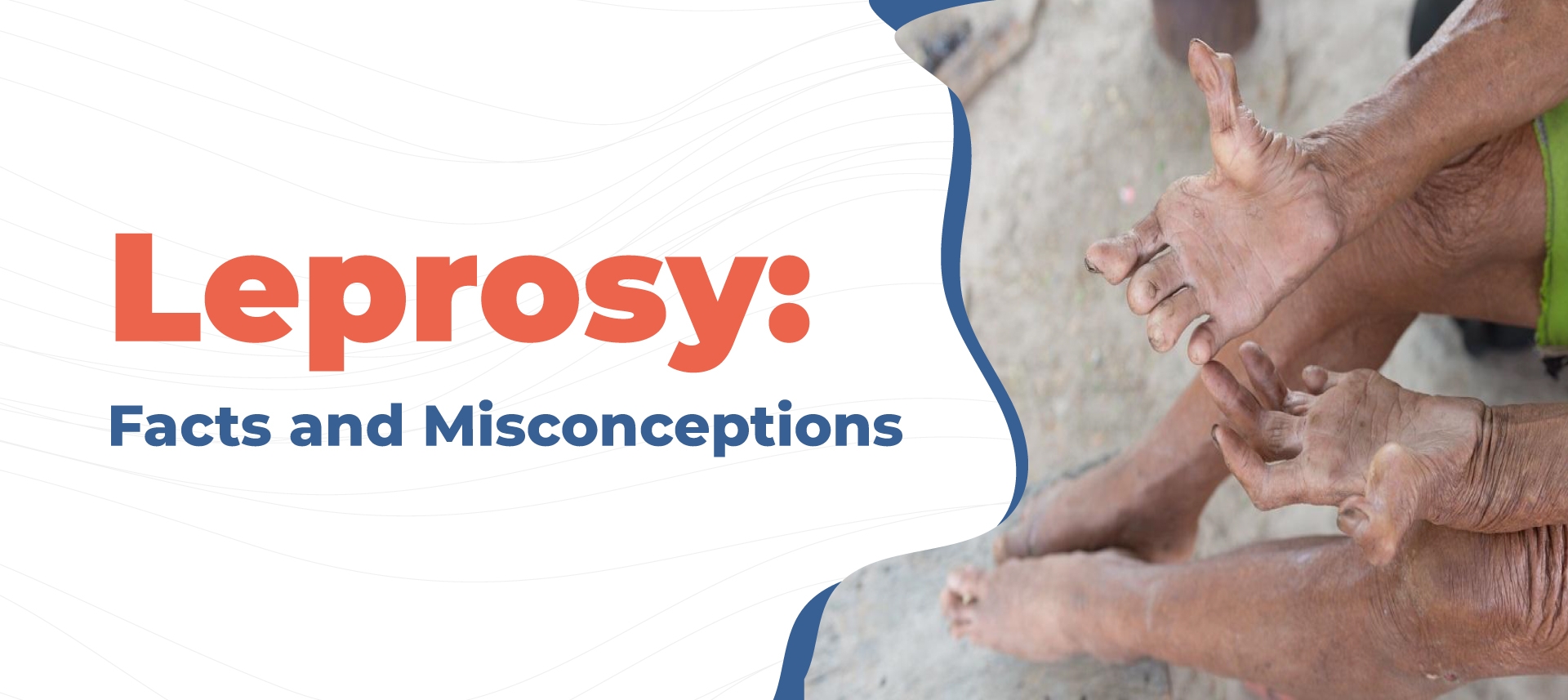Leprosy, also known as Hansen’s disease, is a chronic infectious disease caused by a slow-growing bacterium known as Mycobacterium leprae, an acid-fast, rod-shaped bacillus. The disease mainly affects the skin, the peripheral nerves, mucosa of the upper respiratory tract, and the eyes. Leprosy is curable and treatment in the early stages can prevent disability.
Around the world:
- The number of new cases reported globally to the World Health Organization (WHO) in 2019 was more than 200,000.
- Close to 15,000 children were diagnosed with Hansen’s disease in 2019, more than 40 a day.
- An estimated 2 to 3 million people are living with Hansen’s disease-related disabilities globally.
- In 2019, the countries with the highest number of new diagnoses were India, Brazil, and Indonesia.
- Over half of all new cases of Hansen’s disease are diagnosed in India, which remains home to a third of the world’s poor, a group disproportionately affected by the disease.
In Uganda:
Leprosy has historically posed a public health challenge in Uganda. The disease is currently endemic; with 42 out of 112 districts reporting at least one case of leprosy in 2016, putting the prevalence at 0.07 cases per 10,000.
The NTLP has implemented interventions to reduce the burden, such as community skin camps (community outreaches with free leprosy screening), refresher training of health workers, and contact tracing visits, particularly in areas endemic for leprosy. Despite these efforts, new cases are still being reported in Uganda.
During 2015/2016, 217 new leprosy cases were reported, a new case detection rate of 0.6/100,000. Of the 217 cases, 6% were in children < 15 years old and of those 69% were from the high burden region (Northern), indicating relatively recent spread at the community level. Approximately 27% of leprosy patients had Grade 2 disabilities (severe visual impairment or visible deformities) at diagnosis, indicating a substantial delay in case detection.
Mode of Transmission:
Leprosy was once feared as a highly contagious and devastating disease, but now we know that it does not spread easily and the treatment is highly effective. It is likely transmitted via droplets, from the nose and mouth during close and frequent contact with untreated cases. Prolonged close contact with someone with untreated leprosy is needed to catch the disease. One can not get leprosy from casual contact with a person who has the disease like;
- Shaking hands or hugging.
- Sitting next to each other on the bus.
- Sitting together at a meal.
The disease is not transmitted from mother to child during pregnancy and neither is it sexually transmitted.
Symptoms:
The main symptoms of leprosy include muscle weakness, numbness in the hands, arms, feet, and legs & skin lesions.
How Leprosy spreads:
The skin lesions result in decreased sensation to touch, temperature, or pain. They don’t heal, even after several weeks. They’re lighter than your normal skin tone or they may be reddened from inflammation.
It’s thought that leprosy spreads through contact with the mucosal secretions of a person with the infection. This usually occurs when a person with leprosy sneezes or coughs. Close, repeated contact with an untreated person for a longer period of time can lead to contracting leprosy.
The bacterium responsible for leprosy multiplies very slowly. The disease has an average incubation period (the time between infection and the appearance of the first symptoms) of five years, according to the World Health Organization. Symptoms may not appear for as long as 20 years. According to the New England Journal of Medicine, an armadillo native to the southern United States and Mexico can also carry the disease and transmit it to humans.
How the diagnosis is made:
Your doctor will conduct a physical exam to look for telltale signs and symptoms of the disease. They’ll also perform a biopsy in which they remove a small piece of skin or nerve and send it to a laboratory for testing.
Your doctor may also perform a lepromin skin test to determine the form of leprosy. They’ll inject a small amount of leprosy-causing bacterium, which has been inactivated, into the skin, typically on the upper forearm. People who have tuberculoid or borderline tuberculoid leprosy will experience a positive result at the injection site.
Treatment:
WHO developed a multidrug therapy in 1995 to cure all types of leprosy. It’s available free of charge worldwide. Additionally, several antibiotics like dapsone, rifampin, clofazimine, minocycline, & ofloxacin treat leprosy by killing the bacteria that causes it. Your doctor will likely prescribe more than one antibiotic at the same time.
They may also want you to take an anti-inflammatory medication such as aspirin, prednisone, or thalidomide. The treatment will last for months and possibly up to 1 to 2 years and lead to a total cure of the disease.
Potential complications:
Delayed diagnosis and treatment can lead to serious complications including:
- Disfigurement
- Hair loss, particularly on the eyebrows and eyelashes
- Muscle weakness
- Permanent nerve damage in the arms and legs
- Inability to use hands and feet
- Chronic nasal congestion, nosebleeds, and collapse of the nasal septum
- Iritis, which is an inflammation of the iris of the eye
- Glaucoma is an eye disease that causes damage to the optic nerve
- Blindness
- Erectile dysfunction (ED)
- Infertility
- Kidney failure
Prevention:
The best way to prevent leprosy is to avoid long-term, close contact with an untreated person who has the infection. Early detection and full treatment of the existing cases also helps to prevent the continuous spread of the disease.
Risk factors:
- Close Contact: Close contact with leprosy patients increases the risk of contracting the disease especially with the subtype lepromatous leprosy.
- Immunosuppression: Immunosuppressed patients have a higher risk of being infected by the mycobacteria. In the particular case of HIV patients, the infection by the HIV has not been noted to increase vulnerability for the development of leprosy. Additionally, some studies have reported activation of latent mycobacteria leprae with exacerbation of previous lesions, once the antiretroviral therapy is started, possibly due to reconstitution of the immune response against the bacteria.
- Armadillo Contact: Armadillos serve as a reservoir for the disease, and armadillos contact increases the risk of transmission of disease.
- Genetic Risk Factors: The immune response mounted against the mycobacteria have both innate and acquired components. It has been noted that variants of the NOD2-mediated signalling pathway, a regulator of the innate component, have a higher risk of developing leprosy.
- Age: There is a bimodal distribution in the incidence of leprosy, with an increased incidence between the ages of 5 and 15 years, and then another increase after the age of 30.
- Endemic Regions: People living in endemic regions along with poor hygiene and poor nutritional status are at increased risk of contracting leprosy. These countries include Angola, Brazil, the Central African Republic, the Democratic Republic of Congo, the Federated States of Micronesia, India, Kiribati, Madagascar, Mozambique, Nepal, Republic of the Marshall Islands & the United Republic of Tanzania.
- Tattooing: The bacteria have been transferred during tattooing in India.
Misconceptions about Leprosy
Question: Is leprosy very contagious (easy to catch)?
Answer: Leprosy (Hansen’s disease) is hard to catch. In fact, 95% of adults cannot catch it because their immune system can fight off the bacteria that causes HD.
Question: Can leprosy cause the fingers and toes to fall off?
Answer: The digits do not “fall off” due to leprosy. The bacteria that causes leprosy attacks the nerves of the fingers and toes and causes them to become numb. Burns and cuts on numb parts may go unnoticed, which may lead to infection and permanent damage, and eventually, the body may reabsorb the digit. This happens in the advanced stages of untreated disease.
Question: Is leprosy described in historical texts same leprosy we know today?
Answer: Historical leprosy is not the same as modern leprosy. The “leprosy” found in historical and religious texts described a variety of skin conditions from rashes and patchy skin to swelling. They were noted to be very contagious, which is not true for Hansen’s disease. Historical leprosy also did not have some of the most obvious signs of modern Hansen’s disease, like disfigurement, blindness, and loss of pain sensation. The term was also used for mildew on a person’s clothes, possessions or living quarters.
Question: Do people who have leprosy need to live in special houses isolated from healthy people?
Answer: People with leprosy who are being treated with antibiotics can live a normal life among their family and friends and can continue to attend work or school.
Question: Can you get leprosy when sitting next to someone who has the disease?
Answer: You cannot get leprosy through casual contact such as shaking hands, sitting next to, or talking to someone who has the disease.
Question: Is there a cure for leprosy?
Answer: Leprosy can be cured with antibiotic treatment.
Question: How long is someone with leprosy contagious?
Answer: A person is not contagious after a few days of starting the treatment with antibiotics. However, the treatment must be finished as prescribed (which may take up to 2 years) to make sure the infection doesn’t come back.
Written by Ivan Kagolo (MCO)
Fact-checking by Dr Priscilla Apolot
References:
- Eichelmann K. Leprosy. An update: definition, pathogenesis, classification, diagnosis, and treatment. Actas Dermosifiliogr. 2013;104(7):554–563. [PubMed] [Google Scholar]
- Organization, W.H . 2018. Leprosy factsheet.http://www.who.int/mediacentre/factsheets/fs101/en/ [Accessed 2022 January]; Available from: [Google Scholar]
- Program. U.S. Department of Health Resources and Services Administration; 2015. A summary of Hansen’s disease in the United States. [Google Scholar]
- Domozych R. Increasing incidence of leprosy and transmission from armadillos in Central Florida: a case series. JAAD Case Rep. 2016;2(3):189–192. [PMC free article] [PubMed] [Google Scholar]
- Truman R.W. Probable zoonotic leprosy in the southern United States. N Engl J Med. 2011;364(17):1626–1633. [PMC free article] [PubMed] [Google Scholar]
- Boggild A.K. Leprosy in Toronto: an analysis of 184 imported cases. CMAJ. 2004;170(1):55–59. [PMC free article] [PubMed] [Google Scholar]
- Rendini T., Levis W. Autochthonous Leprosy without Armadillo Exposure, Eastern United States. Emerg Infect Dis. 2017;23(11):1928. [PMC free article] [PubMed] [Google Scholar]
- 2017. Health, Florida department of health reportable and infectious diseases (Hansen’s disease) [Google Scholar]
- WHO; 2018. Repository, global health observatory data, number of new leprosy cases. [Google Scholar]
- Virk A. Mycobacterium lepromatosis lepromatous leprosy in US citizens who travelled to disease-endemic areas. Emerg Infect Dis. 2017;23(11):1864–1866. [PMC free article] [PubMed] [Google Scholar]
- Sotiriou M.C., Stryjewska B.M., Hill C. Two cases of leprosy in siblings caused by Mycobacterium lepromatosis and review of the literature. Am J Trop Med Hyg. 2016;95(3):522–527. [PMC free article] [PubMed] [Google Scholar]
- Ramos J.M., Romero D., Belinchon I. Epidemiology of leprosy in Spain: the role of the international migration. PLoS Negl Trop Dis. 2016;10(3) p. e0004321. [PMC free article] [PubMed] [Google Scholar]
- Wang Y., Rayer Stefan. 2016. Foreign in-migration to Florida, 2005 – 2014 bureau of economic and business research.https://www.bebr.ufl.edu/population/website-article/foreign-migration-florida-2005 [cited 2018; Available from: –2014. [Google Scholar]
- Anderson K.L. A case of leprosy in central Florida. Cutis. 2017;100(5):327–329. [PubMed] [Google Scholar]
- Bonnar P.E. Leprosy in Nonimmigrant Canadian man without travel outside North America, 2014. Emerg Infect Dis. 2018;24(1):165–166. [PMC free article] [PubMed] [Google Scholar]
- Harb J. Two cases of lepromatous leprosy from exposure to armadillos in Florida. Skinmed. 2017;15(5):391–393. [PubMed] [Google Scholar]
- Villada G. Autochthonous borderline tuberculoid leprosy in a man from Florida. Lepr Rev. 2016;87(1):101–103. [PubMed] [Google Scholar]
- Loughry W.J. Is leprosy spreading among nine-banded armadillos in the southeastern United States? J Wildl Dis. 2009;45(1):144–152. [PubMed] [Google Scholar]


